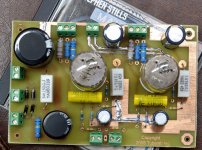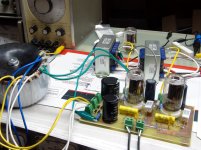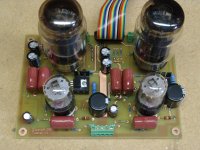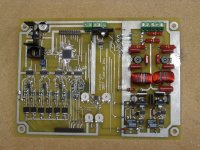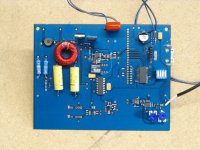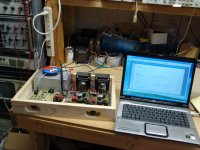I think it's a brilliant idea
Me too!...very cool..... of course George will have to rename Tubelab to "Digital Transistorlab"
I was reading a review on the Israel.......
I never put much faith, or even read magazine reviews of products, since there are too many biases present, usually free products or $$$$. These experiences date back to well before I got (re)involved in making tube amps.
Photography, high performance automotive products, and especially sports supplements reviews in magazines were often tainted or flat out lies. I have no knowledge of this particular amp, and can only guess as to how it is connected up based on the limited information available.
It may indeed be an excellent design, just not a road I choose to venture down again. I found the 6EM7 tubes to be quite variable and inconsistent in the gain in the first stage, and I had several hundred of them to play with. It does show up quite often in budget single tube "spud" amp designs which work reasonably well for their price point. I made one about 10 years ago, but decided that the 6DN7 worked better, and the 6GF7 even better still. I still have the 6GF7 version. It almost became a Tubelab product, the Spud SE. See pictures.
The 5842 is becoming scarce. The TSE is a two stage design, and will remain so, so the twin triode TV sweep tubes are not an option. There are other suitable choices, but I don't have the time to really evaluate them all right now.
shocking that a decade has passed, but no one has followed up on it.
It was published in Circuit Cellar magazine which always catered to the digital DIY crowd. I got some interest right after publication including a phone call from Hartley Peavey asking about it's potential for big guitar amps. Sadly the amp as designed just didn't sound right for a guitar amp in clipping, so it wouldn't make it in the guitar amp world. About a year later I got an email revealing that some enterprising individuals in the UK had attempted to patent my design and had the stones to use verbage lifted verbatim from the magazine article......no word how that turned out.
Interest pretty much died out within a year or so, and I haven't had the time to look back into it. Recent rekindled thoughts about building a kilowatt vacuum tube HiFi amp got me poking around with the old design and realizing that it has some hard to overcome challenges for use in a push pull amp. So far all "research" has resided in the mind of the simulator. Kilowatt level stuff is expensive and really scary when it blows up, so.....little steps at a time.
it be a separate controller board that can be integrated into existing designs
The concept for a modulated power supply will only work on an amplifier design that uses a cathode follower output stage. Searching this entire forum will turn up maybe half a dozen of them, primarily due to their huge drive voltage requirements, hence the 6EM7.....it was made to drive TV deflection yokes.
hand / glove relationship between the amp and controller, in other words, the two are specifically made for each other?
Given a suitable SE cathode follower design, the controller could be retrofitted into it. The controller supplies B+ to the output tubes, and has monitoring points in the amp to pick up signal, and measure tube currents. The design presented in the article used the PIC chip to automatically set the bias points for all 4 tubes on power up. It could also store and keep track of this info, and even test / match tubes. These were the "claims" in the UK patent application.
Lastly, make it SMD, no components smaller than 0805, preferably 1206, please ...
The amp was all leaded components. The controller used SMD, 0805 and bigger. The blue board is an early test board for the digital section. See pictures.
The last picture shows the "tune up." Setting the bias and optimizing for power and distortion using a laptop! I still don't think the tube amp world is ready for that one, but my kilowatt will have a processor and a USB port.....if it ever gets built.
Attachments
I have build a couple of kits (VTA-M125s) and have long wanted to build the TSE amplifier, and now that there is a new upgraded circuit board that will soon be ready, I have decided to finally build it. I plan to build a 300b with 5k OPT and B+ of 390 to 400v. I have done a huge amount of research and read most of Georges extremely informative web site at least twice and have already started to plan and order the iron and other various other components in anticipation.
I have a question about the 5842 valve. I have read that this can be replaced by an EC8010 valve with several people saying that the sound is much better with the EC8010 than the 5842 valve and would like to try this valve.
Would it be OK to substitute the 5842 with an WC8010 valve in the TSE design (driving a 300B valve)?
Thanks.
I have a question about the 5842 valve. I have read that this can be replaced by an EC8010 valve with several people saying that the sound is much better with the EC8010 than the 5842 valve and would like to try this valve.
Would it be OK to substitute the 5842 with an WC8010 valve in the TSE design (driving a 300B valve)?
Thanks.
Would it be OK to substitute the 5842 with an WC8010
Despite what some would have you believe, these are NOT pinout compatible. Could someone hack up the PC board and wire an EC8010 into the TSE? Yes, if they knew what they were doing. Would it work better? It's doubtful that it would produce a lower distortion number. Would it sound different than the 5842? Maybe, I don't have any, and they are hard to find in the US, so I don't know. Different, may sound better to some, and worse to others....unless it was really a lot different.
The 5842 was selected over 15 years ago because it consistently produced the lowest distortion at the output level needed to drove a 300B compared to all the tubes that I had available to me. At that time I had a warehouse that held over 100,000 tubes. Is there something better out there? Maybe, it is possible. Is there something out there that is easier to find that is as good, or "good enough," whatever that is? Maybe, but it's going to take some time to test a bunch of tubes.....and I don't have that time right now.
As soon as I verify a few more things, and assuming nothing bad is found, the TSE-II board as it sits now will be sent to a board house for duplication. When the first batch comes in, I will need to build some boards and make some build documentation.....maybe even a Youtube build video.
Despite what some would have you believe, these are NOT pinout compatible.
Thanks for the detailed response. When I think about it, the articles I read were I think were mainly talking about substitution in the design, rather than direct substituting in a finished amp, so probably my bad for assuming they could be directly substituted.
I am now a proud owner (allbeit undelivered as of now) of a matched pair of mill grade 5842s.
Excellent news on the board, I can't wait!
I have one request for the documentation of the parts list, which you may already be planning. Would it be possible to update the parts list for the parts that are obsolete (other than the ICs that I know you are doing anyway). I have started looking for some of the components and quite a few of the resistors and capacitors are obsolete. Also, as a nice to have, it would be very nice to have a choice of good quality and excellent quality, at least for the components where this would matter for. This build I want to try to use excellent quality (within reason and where appropriate). This build will be for myself. I plan on doing another build using the cheapest best bang for buck components to try to hear the difference and then selling the amp to a friend at cost.
Thanks for all your work.
When the first batch comes in, I will need to build some boards...
If you need a beta builder volunteer, give me a shout!
assuming nothing bad is found, the TSE-II board as it sits now will be sent to a board house for duplication
Do you happen to have the ICs and voltage regulator part numbers, which I understand will probably be new, so that I can order some in preparation (or should I start a new thread for this).
Thanks.
Here is the parts list that I used to build the first two prototypes. This is only what I ordered. Most of the resistors came from my stock, so I need to go through the boards to see what I put in them and find proper part numbers.
No guarantees that something won't change, but I have seen no issues so far. I let the amp play every day for nearly 2 weeks with 2A3's (worse case on the regulator). Then I put 45's in it and played it daily for over a week.
I even hooked up some small Edcor XSE15-8-5K OPT's and connected the secondaries DIRECTLY to my 32 ohm headphones. I wouldn't recommend this since a loose input cable can put over 2 watts into your headphones. The phones, your head, or BOTH might EXPLODE.....but it sounds real nice and very quiet when turned down.
A contract engineering job has sucked up much of my time lately, but I will swap 300B's into it, requiring a resistor change for the 5 volt filament, in the next day or two. If all goes well, I'll order a batch of boards.
NOTE.....The old version of the BOM that was posted here has been removed to avoid confusion. The latest version is in POST #1 and that's where the most current version will be kept. The idea is to avoid having multiple inconsistent BOM's.
No guarantees that something won't change, but I have seen no issues so far. I let the amp play every day for nearly 2 weeks with 2A3's (worse case on the regulator). Then I put 45's in it and played it daily for over a week.
I even hooked up some small Edcor XSE15-8-5K OPT's and connected the secondaries DIRECTLY to my 32 ohm headphones. I wouldn't recommend this since a loose input cable can put over 2 watts into your headphones. The phones, your head, or BOTH might EXPLODE.....but it sounds real nice and very quiet when turned down.
A contract engineering job has sucked up much of my time lately, but I will swap 300B's into it, requiring a resistor change for the 5 volt filament, in the next day or two. If all goes well, I'll order a batch of boards.
NOTE.....The old version of the BOM that was posted here has been removed to avoid confusion. The latest version is in POST #1 and that's where the most current version will be kept. The idea is to avoid having multiple inconsistent BOM's.
Last edited:
Here is the parts list that I used to build the first two prototypes. ... If all goes well, I'll order a batch of boards.
Thanks for that, much appreciated. Looking forward to the boards when they are ready. Is it possible to pre-reserve a board from the first batch?
Is it possible to pre-reserve a board from the first batch?
There will be plenty. The price break for affordability starts at a quantity of 50 boards. That usually lasts about a year, two years for the SPP. If they sell fast, I'm sure that I can get more before I run out. I seriously doubt that running out will be a problem.
Board sales usually drop off in spring, reach near zero over the summer and return in fall. The drought came early this year. There is one order for all of March so far. There should be plenty of boards to go around.
As with all of my new creations, a few will be "offered up to science" too. Expect to see something crazy like a Sweep tube TSE-II, and some hacked up boards to test alternative driver tubes.
I just noticed your flag......My contract job involves some chips from Nordic semiconductor.
Last edited:
I even hooked up some small Edcor XSE15-8-5K OPT's and connected the secondaries DIRECTLY to my 32 ohm headphones. I wouldn't recommend this since a loose input cable can put over 2 watts into your headphones. The phones, your head, or BOTH might EXPLODE.....but it sounds real nice and very quiet when turned down.
Off topic - but the TSE with 45 tubes makes a superb headphone amp, I am using one with some custom made output transformers from Toroidy and it wipes the floor with all the solid state headphone amps I have owned previously.
Off topic - but the TSE with 45 tubes makes a superb headphone amp, I am using one with some custom made output transformers from Toroidy and it wipes the floor with all the solid state headphone amps I have owned previously.
I have a working 45 based TSE with electraprint output iron, made with secondaries for cans.
It really rocks. I'm trying to finish the case for it now, to give it a good home.
a few will be "offered up to science" too. Expect to see something crazy like a Sweep tube TSE-II
I just noticed your flag......My contract job involves some chips from Nordic semiconductor.
Excellent news! I have already read with interest your page about the TSE-I 6LW6 Sweep Tube. The OTP that I have bought now are way oversized for a 300B, but were bought with the aim of using them with higher powered tubes in the future. So I would certainly be interested in any sweep tube TSE-II experiments.
Yeap, though we are a small country, Norway has some quite large and good technology firms. Another huge technology firm is Kongsberg Gruppen, which consists of Kongsberg Maritime, Kongsberg Defence & Aerospace and Kongsberg Digital.
Last edited:
BTY, I have ordered most of the components from Digikey in the BOM you posted but got an email from them saying that part 3309P-1-102: TRIMMER 1K OHM 0.5W PC PIN TOP is now obsolete and a replacement (min order 2000!) is part: 37PR1KLF-ND. They have enough stock to send me the ones I ordered, but may be not for other people ordering this.
Also, is there are any differences between the 6LW6 26LW6 and 36LW6 Sweep Tubes, other than their filament voltages?
Also, is there are any differences between the 6LW6 26LW6 and 36LW6 Sweep Tubes, other than their filament voltages?
Very interesting Project the new TSE... One question, What do you think about the posibility of use a 7.5A regulator instead of 5A for the people that plan to use 2A3 tubes?
In digikey there is MIC29752WWT that seems the same pinout that MIC29502WT proposed by George in his BOM... but with a max current of 7.5A.
In digikey there is MIC29752WWT that seems the same pinout that MIC29502WT proposed by George in his BOM... but with a max current of 7.5A.
is there are any differences between the 6LW6 26LW6 and 36LW6 Sweep Tubes
On paper, no there isn't. In reality there are several tubes called _LW6 that are quite different from each other. There are two US manufacturers of these tubes, GE and Sylvania, regardless of whose name is printed on the glass.
The GE tubes seem to come only in a fat 1.75 inch bottle. I believe that I have seen some skinny GE 26LW6's but I'm not really sure on that. There have been several different plate structures over the years in the GE tubes, usually different types of additional heat radiating fins welded to the plate. There are also GE tubes with no extra fins. The tubes with no fins start to red plate anywhere from 50 to 70 watts depending on how well they were made. The tubes with the huge mega fins can eat 90 watts with no redness.
The Sylvania tubes are most often found in the skinny 1.5 inch bottle with to heat radiating fins. I have seen some early vintage Sylvania made tubes in the fat bottle with fins.
There are also some Japanese made 36LW6 tubes in the fat bottle with a huge internal structure. I have two very used examples, but haven't tried them yet.
part 3309P-1-102: TRIMMER 1K OHM 0.5W PC PIN TOP is now obsolete
That's the unfortunate and difficult part of making small runs of any electronics these days. Fortunately those were a common footprint and Piher pots will fit the board and work fine, but cost twice as much, and there is no 1 K part. I put 2 K parts in my second board and they work fine. I will update the parts list to reflect this when I go through my board to see what parts are actually in it.
What is the distance center to center of the output tubes?
3.6 inches
but was wondering if you ever tried the 6sf5?
For those who don't know the 6SF5 is an old octal tube that was the predecessor to the 12AX7. It is available in metal and glass envelope, with metal being far more common. When I was a kid I would strip TV's, radios, and HiFi sets for parts for DIY guitar and stereo amps. I used the 6SF5 for the input stage in some guitar amps. It wasn't a very common tube then, and is probably a bit harder to find today.
I have a large box of used metal tubes that I got for free at a hamfest a few years ago. There are some 6SF5's and several other goodies including some metal 6L6's and eight shiny metal 6V6's. I have already tested the metal 6V6's in my Universal Driver test amp. I'm thinking about building a guitar amp called MetallicAmp.......all tube, no glass! It should use only stuff that was available in 1940......like what Leo Fender COULD have built if he wasn't chasing cost so hard! I don't think a metal octal tube would be well received in the TSE though, and some of them can be quite microphonic.
What do you think about the posibility of use a 7.5A regulator....In digikey there is MIC29752WWT that seems the same pinout
I considered that part, but it has three strikes against it. Yes the pinout is the same, but the package is not. It's in a much bigger TO-247 package and would require a different board design. Page 3 of the data sheet reveals the words "not recommended for design." This means that the part will go extinct soon. It is also an $18 part.
The MIC29502 seems to work fine with 2A3's, and the internal current limit at about 7.5 amps provides some soft start for the 2A3's and it can handle a bit more than 5 amps
- Home
- More Vendors...
- Tubelab
- After a 14 year run, the TSE must DIE!
